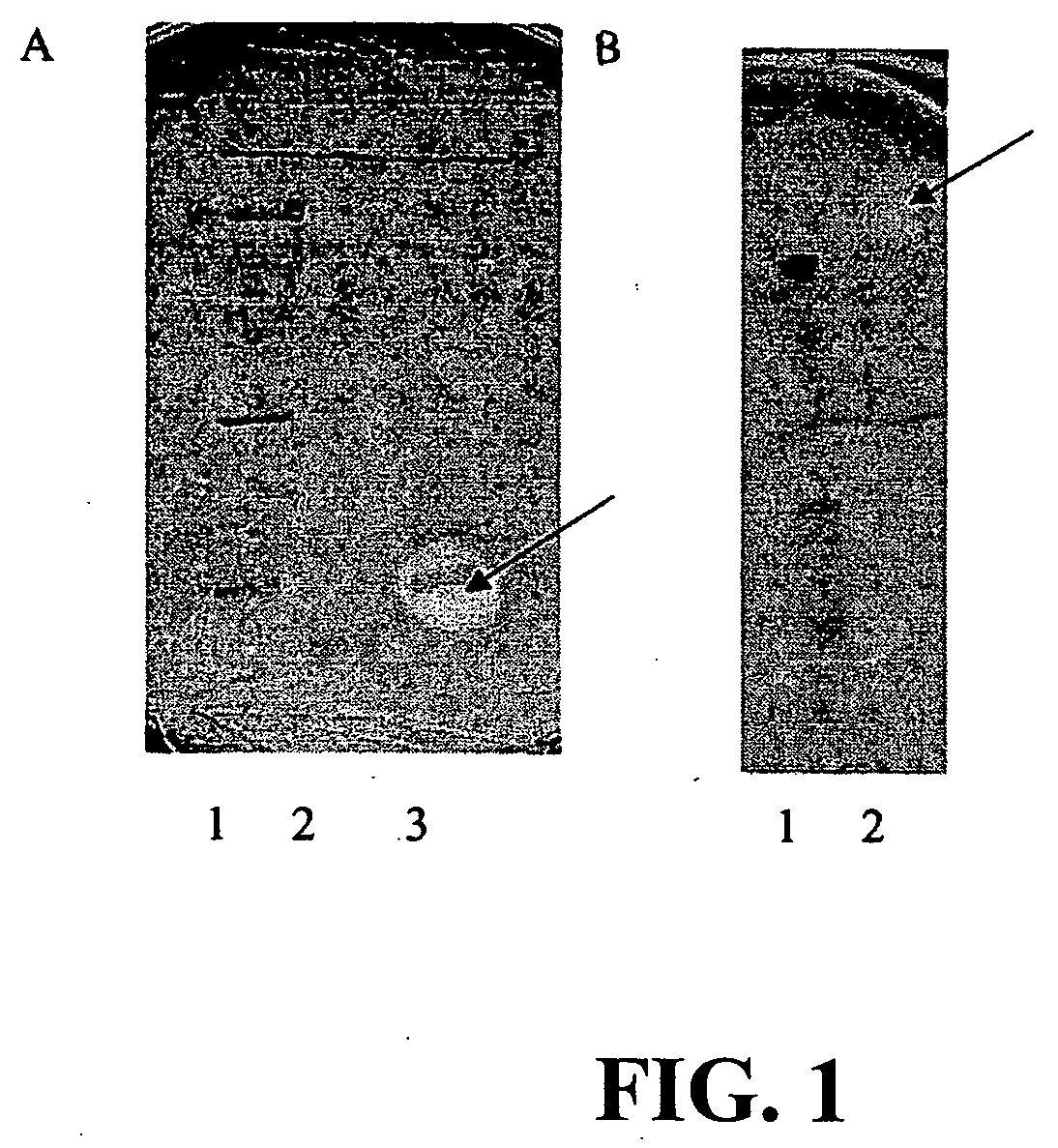Novel enterococcus and streptococcus strains and bacteriocins
a technology of enterococcus and streptococcus, which is applied in the field of new enterococcus and streptococcus strains and bacteriocins, can solve the problems of human intestinal diseases, further contamination of both live birds and carcasses, and diminishing poultry contamination problems, so as to reduce the level of colonization and increase the production of bacteriocins
- Summary
- Abstract
- Description
- Claims
- Application Information
AI Technical Summary
Benefits of technology
Problems solved by technology
Method used
Image
Examples
example 1
[0062] Two novel antagonistic strains, Enterococcus faecium Strain 50-52 (NRRL B-30746) and Streptococcus cricetus Strain 760 (NRRL B-30745) were isolated from mucous surfaces of about 1.0 gram of the ceca of broilers which was suspended in about 10 ml of sterile 0.85% w / v saline solution (normal saline) and heated at about 80° C. for about 15 minutes. Approximately 0.10 ml of about 1:50, and 1:2,500 suspensions was spread plated onto either plate count agar or MRS Agar. Plates were incubated at about 37° C. for about 24 hours under microaerobic conditions. Colonies with different morphology were streaked onto MRS agar. These cultures were incubated under microaerobic conditions for about 24 hours at about 37° C.
[0063] Strain 760 was grown at approximately 37° C. for about 24 hours on MRS Agar. The strain is a facultative aerobe with gram-positive cocci, is able to grow between approximately 37° C. and 45° C. The strain grows on nutrient agar or plate count agar producing circular ...
example 2
[0066] Crude antimicrobial preparations were extracted from cultures of the two antagonistic strains: Enterococcus 50-52 and Streptococcus 760. Antagonists were grown in about 250 ml of 10% Brucella broth together with inducer strain Lactobacoccus lactis Strain 320 (NRRL B-30744, supra) at about 37° C. for about 14 hours under aerobic conditions. Concentration of producer strain was about 106 CFU / ml and for inducer strain about 107 CFU / ml. The resulting cultures were centrifuged at approximately 2,500×g for about 10 minutes, removing most of the viable cells. The decanted supernatant was mixed with about 60% saturated ammonium sulfate and incubated at about 4° C. for about 24 hours to precipitate the bacteriocin compounds. Following centrifugation at approximately 10,000×g for about 20 minutes, the sediment was resuspended in approximately 1.5 ml of about 10 mM phosphate sodium buffer, pH about 7.0, and dialyzed overnight against approximately 2.5 Liters of the same buffer. The solu...
example 3
[0067] The spectrum of antimicrobial activity of the CAPs was determined using a spot test. Approximately 1 ml of sterile crude antimicrobial preparations (CAP), obtained as in Example 2 above, were diluted with approximately 1 ml of phosphate-sodium buffer (pH about 7.0) and sterilized as above in Example 2. Approximately 10 microliters of each sample were plated onto blood-supplemented Campylobacter agar or Nutrient agar (MPA or Meta Peptone Agar) previously seeded with cells of target bacteria. Plates containing cultures of C. jejuni were grown at about 42° C. under microaerobic conditions, Y. enterocolitica and Y. pseudotuberculosis were cultured aerobically at about 28° C., and other bacterial strains were incubated aerobically at about 37° C. for about 24 or 48 hours. Identification was based on inhibition areas produced by the target bacteria. Activity of CAP was expressed in arbitrary units (AU) per one milliliter of the preparation at which a visible zone of inhibition of t...
PUM
| Property | Measurement | Unit |
|---|---|---|
| Temperature | aaaaa | aaaaa |
| Mass | aaaaa | aaaaa |
| Mass | aaaaa | aaaaa |
Abstract
Description
Claims
Application Information
 Login to View More
Login to View More - R&D
- Intellectual Property
- Life Sciences
- Materials
- Tech Scout
- Unparalleled Data Quality
- Higher Quality Content
- 60% Fewer Hallucinations
Browse by: Latest US Patents, China's latest patents, Technical Efficacy Thesaurus, Application Domain, Technology Topic, Popular Technical Reports.
© 2025 PatSnap. All rights reserved.Legal|Privacy policy|Modern Slavery Act Transparency Statement|Sitemap|About US| Contact US: help@patsnap.com


